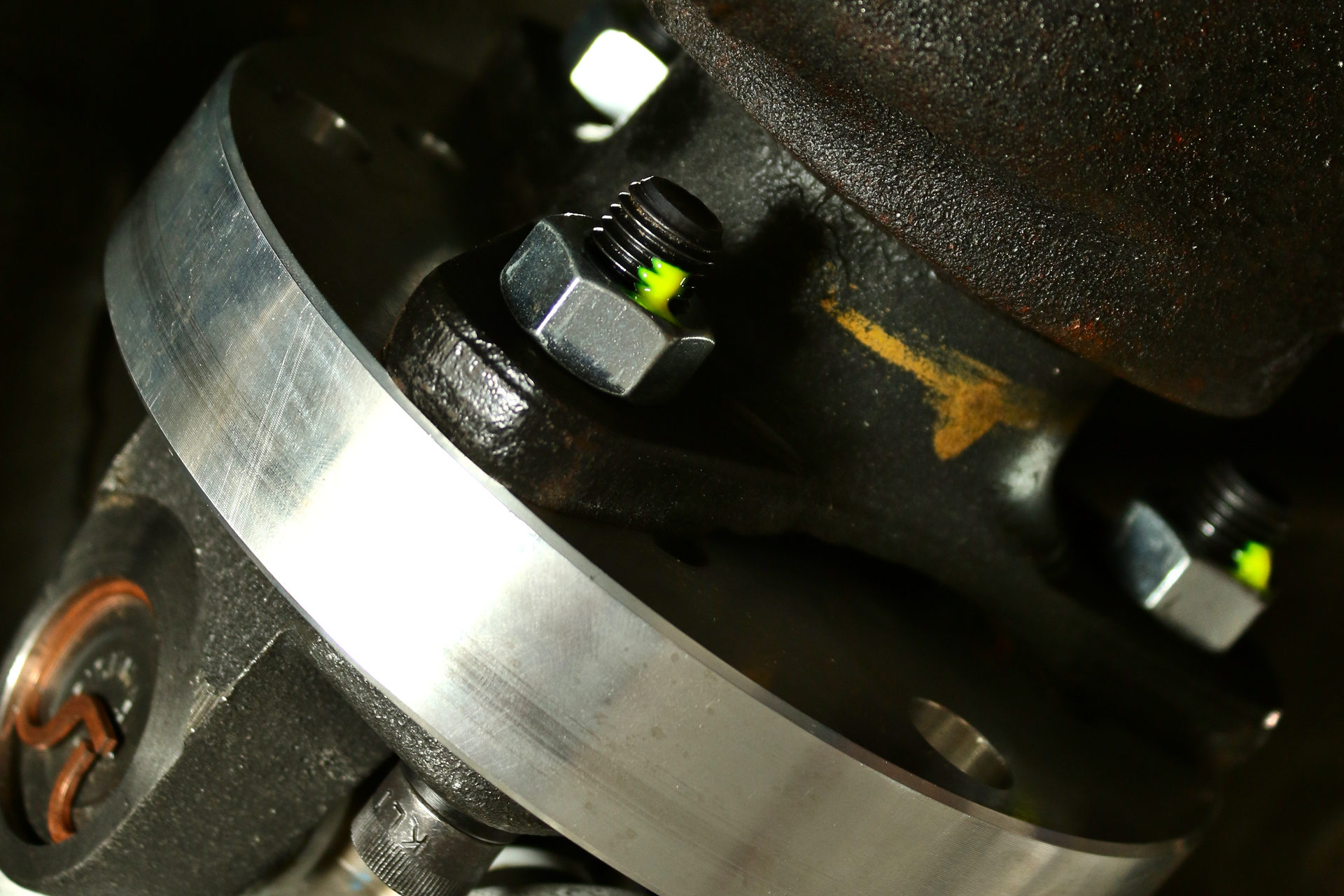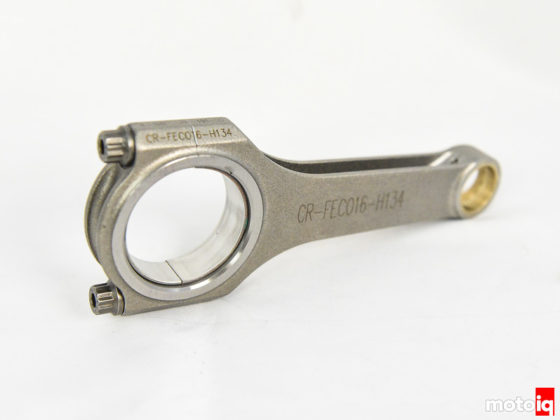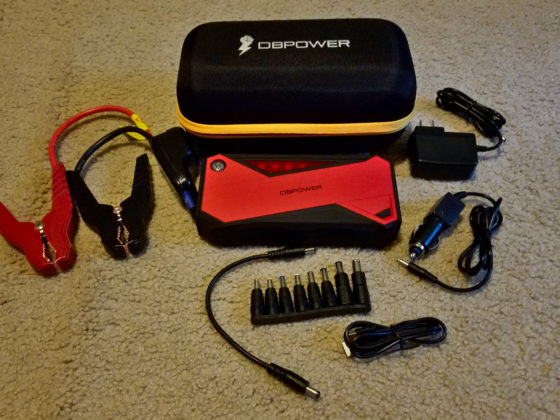


USE ATF AND NOT MTF.
We called the friendly folks at Tremec and, while the label says just to use Dexron III, they assured us that Mobil 1 ATF would be fine. So in it went. Approximately 3.75 quarts of it. L2 uses Mobil 1 ATF wherever ATF is called for, so they happened to have a bit on hand already. The T56 does not come with any oil from the factory. DO NOT FORGET TO FILL YOUR NEW TRANSMISSION WITH OIL. They even leave a giant tag on it so you won’t forget. Don’t forget!

When we were cleaning up the threads on the crank, we had to use a little brake cleaner as well. The 2JZ crank’s flywheel bolt holes are straight through, which means that they’re exposed directly to the engine oil. So we probably had gotten some brake clean in our engine oil. To be safe, we changed the oil.
Also note – this is an added reason to use thread locking compound on the flywheel bolts (to help with fluid seal).




9 comments
Fantastic coverage as always, could you tell me what “aircraft marking paint” you use on those adapter nuts?
I knew someone would ask!
A couple of searches gave me the following:
http://crosschecknow.com/
This product is also available in several other places.
Thanks for putting me to task 🙂
> If I needed to put the car in reverse for some reason, I would have to consciously turn the switch off. I’d need to remember to put it back on, but that’s not so hard, is it?
When the car is already in reverse, it doesn’t matter what the solenoid does right? Maybe you can use a momentary switch, so that you need to hold that switch to enter R. Or program that switch to hold the solenoid open a few seconds only.
Good points.
My guess is that the lockout solenoid causes a physical blockage of the shift gate from entering the R position. If the car is IN reverse, and you try to engage the solenoid, I’m not actually sure what would happen! Good question for me to ask Tremec.
A momentary / programmed function could work for sure, assuming that engaging the lockout solenoid while the car is IN reverse has no ill effects.
Assuming the Tremec transmission has a reverse position switch (for example, IIRC Nissan and Toyota transmissions have a detent on the rail for reverse, which closes the switch when in said position), which it absolutely should for the sake of having a reverse light, one could in theory use some fairly simple programming to have the reverse lockout closed EXCEPT in moments where 1) the vehicle isn’t in motion, which ideally would use wheel speed sensors for reference and 2) when the reverse position switch is closed, thus the lockout wouldn’t try to engage while the vehicle is in reverse. I say “in theory” because it has been literal years since I had to commit CAN databus serial data protocols to memory, so I must admit right this second I’m not sure how one would go about doing that unless your ECU receives signals from your wheel speed sensors, has a spare digital input pin for the reverse position switch, and also a spare digital output pin, not to mention some sort of built in programming to reference those values and output an on/off signal based on the conditions I suggested earlier. Alternatively, one could technically program an Arduino Nano or something like that to look for a CANBUS header message for vehicle speed with a reading of zero or a closed condition on the reverse position switch circuit, and open the reverse lockout solenoid under either condition with a relay, but good lord that scenario seems like overkill to me, although certainly not crazy expensive.
My experience with TR-6060 equipped vehicles is limited primarily to alignments/oil changes/test drives, but I had taken apart quite a few Toyota/Nissan RWD manual transmissions back in school, especially whilst undergoing Nissan-specific training, and I can’t imagine GM/Ford/Tremec would have tried to come up with a design that’d be any more/less simple than a detent switch and a few lines of code.
You’re absolutely right and I have a few options.
Hypothetically the Haltech Elite 2500 ECU can output a signal on one of the digital outputs when the vehicle is in motion.
If not, the Autosport Labs datalogger/GPS can absolutely control a digital output based on vehicle speed. Since it’s reading the CAN from the Haltech, and I wired the wheel speed sensors into the Haltech, the logger knows both real wheel speed and GPS vehicle speedl
As long as the lockout solenoid doesn’t sink a lot of current, it would not be hard to do.
I also have the LAUNCH button on my steering wheel. Since all that does is control a rev limiter, I could also make that button dual-purpose. The logger can see when the button is pressed, so I could also allow the LAUNCH button to disable reverse lockout.
Sounds like as long as nothing goes terribly funky with the wiring to your launch button, that could be an excellent plan, especially since it’s not exactly like momentarily activating your two step wouldn’t be an issue when you’re putting the car into reverse. Maybe use a MOSFET and a dedicated fuse for the solenoid, just to be on the safe side, vis a vis the potential current situation? With the MOSFET you could technically just take virtually any small plastic enclosure (like, say, an old square keyfob), cur out a square big enough to stick a heatsink for the MOSFET through, and fill the enclosure with silicone after wiring the unit up, and have basically something smaller than a relay that doesn’t get affected by weather/vibrations/etc. that gives you some peace of mind, although I personally suspect said solenoid won’t pull enough current for that to become an issue any time soon. All that being said though, couldn’t the solenoid be powered through your RacePak PDM if it did pull too much current for the ECU to handle? I must admit, this suddenly has me curious to see how much current that solenoid uses; if I had a TR-6060 laying around, I’d almost be bothered enough to use one of my spare relays and some jumper wires and find out. I mean, the spring it has to work against can’t be THAT stiff, could it?
Haha, your in-car video sounds more like a plane taking off and doing fly-bys here and there
All in, great to see the car on the road and running!
Thanks! It’s been a long time coming. We’re quite excited to keep at it. Don’t worry – the articles won’t stop.